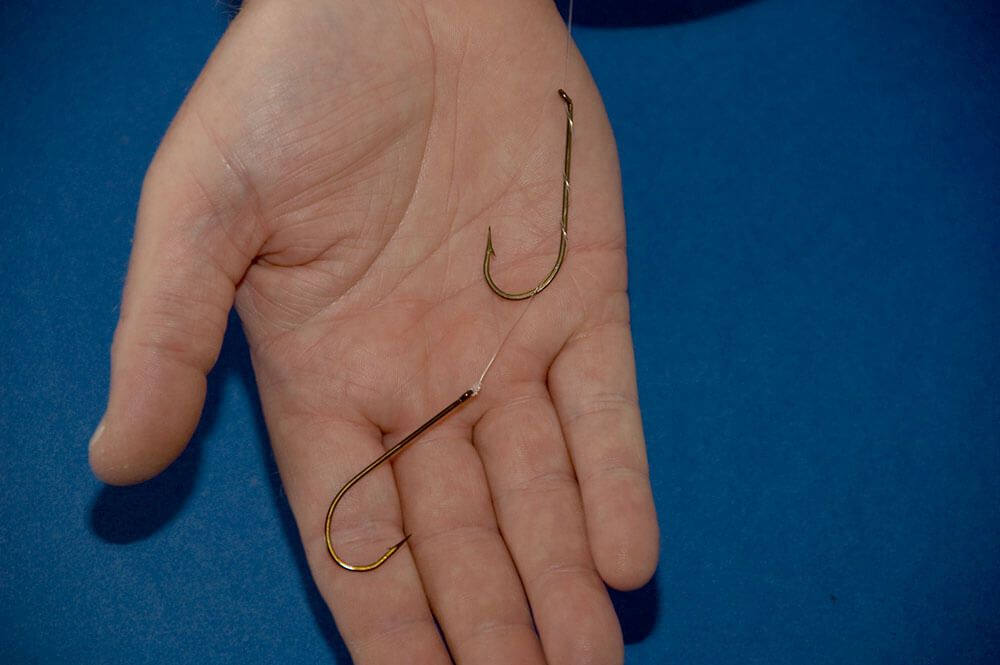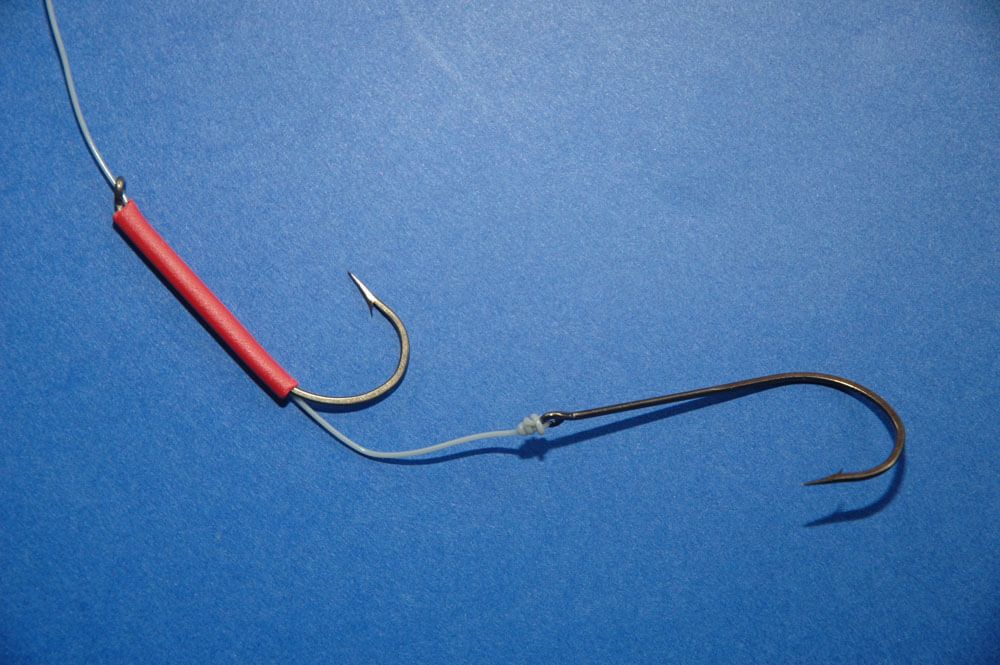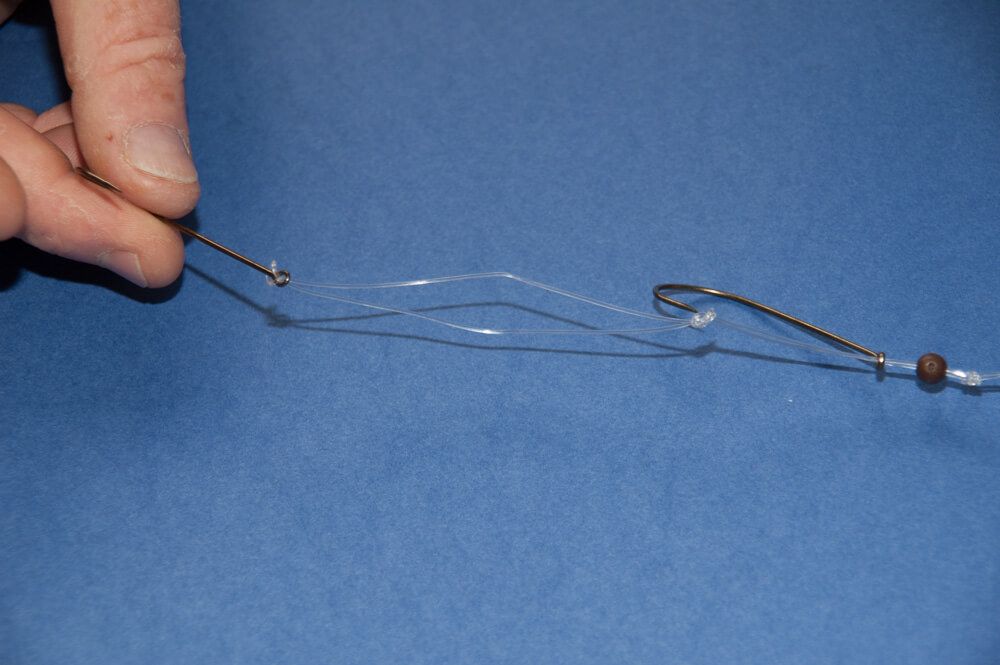A common question sent to WSF, is how to tie 2-hook Pennel rigs.
There are actually three types of common Pennel rig you can use. To clarify each one we’ve shown you how to not just tie them, but also detailed their advantages and disadvantages to highlight which types are best used in specific circumstances.
The two-hook Pennel rig commonly uses a Mustad Viking 79510 top hook, and a Viking 79515 lower hook. The reason these particular hooks are chosen is that the 79510 has a turned down eye and suits the top hook for a Pennel rig perfectly. The 79515 pattern has a straight eye and sits well as the bottom hook. These are proven hooks for strength and penetration when sharpened, but other similar quality patterns will do the same job.
It is not essential to have a turned down eye top hook, but without the turned down eye the line has to travel round the eye of the hook creating an angle in the line and a potential weakness when the line is pulled tight to a lunging and hard fighting fish.
LAZY MAN’S 2-HOOK PENNEL RIG
This is the most common Pennel used by anglers, for as the name suggest, it’s so easy to tie.

Disadvantages: By wrapping the line round the shank of the top hook, where the line exits over the shank on the final lower turn, the line, when pulled, flattens. On small fish this is not enough to cause a problem. When a big double figure fish is hooked, the line under stress flattens around the lower shank and is restricted from stretching. This flattening creates a weakness, especially in cheaper lines of 30lbs and less, and big fish have been lost due to this.
Also if the fish is hooked on the top hook only, and is deep enough inside the mouth, the teeth are working on the line over the hard metal shank of the hook making it more prone to wear and tear. Think about it…it’s easier to cut something with a knife over a hard surface than it is over a soft surface.
The top hook, when positioned in the bait, still has the shank outside the body of the bait fully exposed and creating poor presentation. Not a major concern, but still a factor to consider when fishing in shallow clear seas, plus the line around the shank is exposed to abrasion on the seabed.
It also limits the top hook to being positioned right at the top of the bait.
Advantages: It’s easy and quick to tie!
Easily adjustable for different types and lengths of bait.
TUBE PENNEL RIG
This method of rigging a 2-hook Pennel has been around since the early 1970’s. It’s simple and effective!
[*]Slide on a Mustad 79510 hook by the eye.
[*]Cut a short 1-inch length of 1.5mm electrical tubing.
[*]Pass the hook trace line fully though the tubing.
[*]Slide the tubing over the point of the hook, down over the barb and on to the hook shank so that the hook sits neatly on the line held in place by the tubing.
[*]Tie on the Mustad 79515 hook below the top hook.
[/list]

Disadvantages: Getting the tubing over the hook point and barb can be difficult, even when the tubing has been warmed to make it more supple.
If a big fish takes only the top hook, it can pull the top hook down through the bait until the tubing reaches the knot holding the bottom hook. This puts pressure directly on the knot and is a potential weakness during a long fight. Potentially the eye of the top hook can also slide down inside the tubing if it is not a tight fit and again pressurise the line and lower knot.
The top hook, when placed in the bait, still has the bulk of the shank left exposed giving average presentation.
The top hook can only be positioned at the top of the bait.
Advantages: The Tube Pennel is stronger than the Lazy Man's Pennel, because when a fish takes the lower hook the line remains in a straight line inside the tubing and is pulled directly down to the lower hook eye when under general load.
The tubing makes the line less likely to suffer abrasion from a fish’s teeth.
The top hook is easily adjustable to accommodate different lengths of bait.
THE LOOP PENNEL RIG
[*]On the free end of the hook length form a loop about 6-inches long, but it can be up to 10-inches or more depending on intended bait size, and tie in a double overhand granny knot.
[*]Slide on a size 5mm bead, then a Mustad 79510 Viking hook by passing the end of the loop through the eye of the hook.
[*]2-inches below the hook and bead, tie in another granny knot.
[*]Take a Mustad Viking 79515 hook and pass the end of the loop through the eye, then pass the hook fully through the centre of the loop and pull tight to the eye.
[/list]

Disadvantages: The length of the loop governs the maximum length of bait you can use.
Advantages: Simple and quick to tie!
Because the top hook is held only by the eye it can be easily inverted and pushed down deep inside the top of the bait, the bait then slid fully up the hook and line until it reaches the bead and top knot. This positions the top hook point further down the baits length than the previous two rigs can. Presentation is improved as the shank is hidden inside the bait. Fish cannot attack the middle of the bait so easily and still miss the top hook.
Having a double loop of line makes abrasion from a fish’s teeth highly unlikely.
The double loop is also stronger and less prone to stretch when two hooks are at different angles inside a fish’s mouth. Also when a fish is hooked by just one hook.
If the bottom hook becomes damaged in anyway it can be easily and instantly replaced without upsetting the length dimensions of the hook link when using fixed paternoster rigs that need to be retied.
WHICH PENNEL RIG TYPE TO USE AND WHEN
The Lazy Man’s Pennel is fine for general fishing when after codling and other smaller fish up to say 5lbs. It’s not a good choice when targeting big rays, strap conger, big bass and cod, huss etc, that will grind down on the line around the top hook and potentially cut through and release themselves. I know big fish have been landed on this rig, but be warned, good fish have been regularly lost using it too!
The Tube Pennel Rig is proven, and again is fine for general fishing for smaller fish, plus will handle the odd bigger fish should one happen along. Would I use it when targeting nothing but big fish…no!
The Loop Pennel Rig is the one I choose for the majority of my ray fishing, bass, big cod, strap congers on the rare occasion I use two hooks in tandem for these, for huss and anything else that has sharp, or short, coarse gripping and grinding teeth. I’ve seen 30lb plus shore conger landed on this Loop Pennel after a long scrap with both hooks well down, yet showing no sign of loop damage, so have full faith in it!
At least with the above information, you can choose which type of Pennel suits the majority of your fishing. By getting the choice of Pennel right for the specific size and type of fish in the first place, it dramatically reduces the percentage of losses in your favour.
There are actually three types of common Pennel rig you can use. To clarify each one we’ve shown you how to not just tie them, but also detailed their advantages and disadvantages to highlight which types are best used in specific circumstances.
The two-hook Pennel rig commonly uses a Mustad Viking 79510 top hook, and a Viking 79515 lower hook. The reason these particular hooks are chosen is that the 79510 has a turned down eye and suits the top hook for a Pennel rig perfectly. The 79515 pattern has a straight eye and sits well as the bottom hook. These are proven hooks for strength and penetration when sharpened, but other similar quality patterns will do the same job.
It is not essential to have a turned down eye top hook, but without the turned down eye the line has to travel round the eye of the hook creating an angle in the line and a potential weakness when the line is pulled tight to a lunging and hard fighting fish.
LAZY MAN’S 2-HOOK PENNEL RIG
This is the most common Pennel used by anglers, for as the name suggest, it’s so easy to tie.
- Slide a Mustad 79510 hook on to the hook length via the eye.
- Now tie on the Mustad 79515 bottom hook.
- To secure the top hook after baiting up, position the hook about an inch or so above the bait, wrap the hook length around the shank of the top hook three times and pass the hook point in through the top of the bait for final presentation.

Disadvantages: By wrapping the line round the shank of the top hook, where the line exits over the shank on the final lower turn, the line, when pulled, flattens. On small fish this is not enough to cause a problem. When a big double figure fish is hooked, the line under stress flattens around the lower shank and is restricted from stretching. This flattening creates a weakness, especially in cheaper lines of 30lbs and less, and big fish have been lost due to this.
Also if the fish is hooked on the top hook only, and is deep enough inside the mouth, the teeth are working on the line over the hard metal shank of the hook making it more prone to wear and tear. Think about it…it’s easier to cut something with a knife over a hard surface than it is over a soft surface.
The top hook, when positioned in the bait, still has the shank outside the body of the bait fully exposed and creating poor presentation. Not a major concern, but still a factor to consider when fishing in shallow clear seas, plus the line around the shank is exposed to abrasion on the seabed.
It also limits the top hook to being positioned right at the top of the bait.
Advantages: It’s easy and quick to tie!
Easily adjustable for different types and lengths of bait.
TUBE PENNEL RIG
This method of rigging a 2-hook Pennel has been around since the early 1970’s. It’s simple and effective!
[*]Slide on a Mustad 79510 hook by the eye.
[*]Cut a short 1-inch length of 1.5mm electrical tubing.
[*]Pass the hook trace line fully though the tubing.
[*]Slide the tubing over the point of the hook, down over the barb and on to the hook shank so that the hook sits neatly on the line held in place by the tubing.
[*]Tie on the Mustad 79515 hook below the top hook.
[/list]

Disadvantages: Getting the tubing over the hook point and barb can be difficult, even when the tubing has been warmed to make it more supple.
If a big fish takes only the top hook, it can pull the top hook down through the bait until the tubing reaches the knot holding the bottom hook. This puts pressure directly on the knot and is a potential weakness during a long fight. Potentially the eye of the top hook can also slide down inside the tubing if it is not a tight fit and again pressurise the line and lower knot.
The top hook, when placed in the bait, still has the bulk of the shank left exposed giving average presentation.
The top hook can only be positioned at the top of the bait.
Advantages: The Tube Pennel is stronger than the Lazy Man's Pennel, because when a fish takes the lower hook the line remains in a straight line inside the tubing and is pulled directly down to the lower hook eye when under general load.
The tubing makes the line less likely to suffer abrasion from a fish’s teeth.
The top hook is easily adjustable to accommodate different lengths of bait.
THE LOOP PENNEL RIG
[*]On the free end of the hook length form a loop about 6-inches long, but it can be up to 10-inches or more depending on intended bait size, and tie in a double overhand granny knot.
[*]Slide on a size 5mm bead, then a Mustad 79510 Viking hook by passing the end of the loop through the eye of the hook.
[*]2-inches below the hook and bead, tie in another granny knot.
[*]Take a Mustad Viking 79515 hook and pass the end of the loop through the eye, then pass the hook fully through the centre of the loop and pull tight to the eye.
[/list]

Disadvantages: The length of the loop governs the maximum length of bait you can use.
Advantages: Simple and quick to tie!
Because the top hook is held only by the eye it can be easily inverted and pushed down deep inside the top of the bait, the bait then slid fully up the hook and line until it reaches the bead and top knot. This positions the top hook point further down the baits length than the previous two rigs can. Presentation is improved as the shank is hidden inside the bait. Fish cannot attack the middle of the bait so easily and still miss the top hook.
Having a double loop of line makes abrasion from a fish’s teeth highly unlikely.
The double loop is also stronger and less prone to stretch when two hooks are at different angles inside a fish’s mouth. Also when a fish is hooked by just one hook.
If the bottom hook becomes damaged in anyway it can be easily and instantly replaced without upsetting the length dimensions of the hook link when using fixed paternoster rigs that need to be retied.
WHICH PENNEL RIG TYPE TO USE AND WHEN
The Lazy Man’s Pennel is fine for general fishing when after codling and other smaller fish up to say 5lbs. It’s not a good choice when targeting big rays, strap conger, big bass and cod, huss etc, that will grind down on the line around the top hook and potentially cut through and release themselves. I know big fish have been landed on this rig, but be warned, good fish have been regularly lost using it too!
The Tube Pennel Rig is proven, and again is fine for general fishing for smaller fish, plus will handle the odd bigger fish should one happen along. Would I use it when targeting nothing but big fish…no!
The Loop Pennel Rig is the one I choose for the majority of my ray fishing, bass, big cod, strap congers on the rare occasion I use two hooks in tandem for these, for huss and anything else that has sharp, or short, coarse gripping and grinding teeth. I’ve seen 30lb plus shore conger landed on this Loop Pennel after a long scrap with both hooks well down, yet showing no sign of loop damage, so have full faith in it!
At least with the above information, you can choose which type of Pennel suits the majority of your fishing. By getting the choice of Pennel right for the specific size and type of fish in the first place, it dramatically reduces the percentage of losses in your favour.
